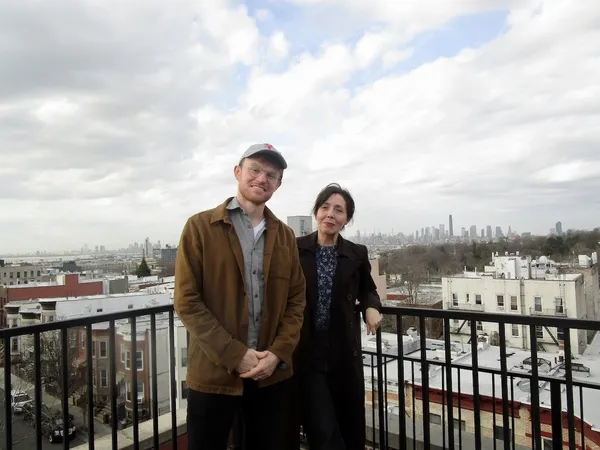 |
| CJ Hunt’s The Neutral Ground co-screenwriter James Hamilton with Anne-Katrin Titze: “Our comedy brain had to be working and our storytelling brain had to be working." Photo: Ed Bahlman |
CJ Hunt’s The Neutral Ground, co-written with James Hamilton (comedian and journalist) and Jane Geisler (who is also the editor), shot by Paavo Hanninen, executive produced by Roy Wood Jr. and Sally Jo Fifer, produced by Darcy McKinnon with co-producer Jeremy Blum, was a highlight of the 20th edition of the Tribeca Film Festival. The documentary is also a co-production of the PBS program POV (season 34), executive produced by Erika Dilday, Justine Nagan, and Chris White, and ITVS, in association with the Center for Asian American Media.
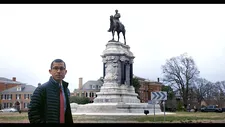 |
| CJ Hunt in front of the Robert E Lee statue in Richmond, Virginia |
In addition, at Tribeca, CJ Hunt received an Albert Maysles Award Special Jury Mention for Best New Documentary Director: "The Neutral Ground directed by CJ Hunt, for the way their use of humour brought audiences into a difficult subject, with vulnerability, authenticity, and at great personal risk."
The Neutral Ground begins in 2015 New Orleans. The debate about the four most prominent Confederate monuments is raging in the City Council and beyond. Then Mayor Mitch Landrieu sums up that it is high time to take down the statues and “put them in a place of proper remembrance, not reverence.” Lightning strikes. The director CJ Hunt on camera takes us on an often surprising and tumultuous journey to what happened next and what had happened long ago to bring about the extraordinary times we live in now in regards to history, race, remembrance, justice.
On the way we meet CJ’s astute dad, Mr. Hunt, count up the days between the vote to take down the monuments and the actual act of removing them from their pedestals, and learn a lot about how history is created in America. During a trip to the archives in Richmond, Virginia, the Capitol of the Confederacy, glimpses at the original documents reveal truths that should make everybody think again about the White League, the Lost Cause, and why Reconstruction failed.
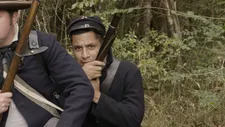 |
| CJ Hunt in a Civil War Confederate reenactment in The Neutral Ground |
With a white-bearded member of the Louisiana Sons of Confederate Veterans, CJ joins a Civil War Confederate reenactment and over the campfire, as the only Black participant, counters the rebel myths and invented narratives with facts and poise. A visit to the slavery museum on a plantation in Edgard, Louisiana and a second reenactment, this time of a slave rebellion offer more insight.
Told by his father to “see the history of his Blackness,” CJ, together with his collaborators, embarks on a large-scale inquiry - the manufacture of history. The Trump presidency, Charlottesville, the George Floyd protests in 2020 - the ebb and flow of progress and regression shown in the documentary are far from over. It feels as though every day the news speaks of a new extreme, a new challenge to be confronted that makes neutrality impossible.
From New York City on April 4, 2023, James Hamilton joined me on Zoom for an in-depth conversation on The Neutral Ground.
Anne-Katrin Titze: Hi, are you across the courtyard?
James Hamilton: I am across the courtyard!
AKT: What a historic day to have this conversation! It’s so fitting!
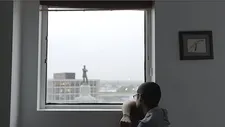 |
| CJ Hunt staring at the Robert E Lee statue in New Orleans |
JH: Yeah, it’s wild.
AKT: This morning I was in Midtown right around the corner from Trump Tower for the Georgia O’Keeffe: To See Takes Time press preview at MoMA. It was totally normal, a day like any other. And yet it isn’t. I noticed the subtitle of your film, actually for the first time today - “a film about sore losers.” How did it come about?
JH: The director, CJ Hunt, is my longtime best friend. He had started rolling on these City Council hearings in New Orleans in 2015. As we talk about in the movie, for CJ this was a chance to make a short, kind of funny YouTube video about this seemingly local absurd issue which was that the city was not able to bring down these Confederate monuments. People who were coming out to protect these monuments seemed very absurd. So absurd that it seemed like a harmless joke in a way.
As the movie details, CJ realises this is a much deeper serious issue. As I came on and a bunch of the team was there, there was still this undertone of the fact that the United States can’t let the Confederacy go, even though it’s so clearly this toxic old romance. So we saw it through this toxic relationship sense for a while and over time as things got more serious it was like - oh this is just a sore loser story. This is: You lost and you’ve gone through such great lengths to literally rewrite the history books, so that you and your side don’t actually have to tell the truth of what happened. And if that is not the epitome of being a sore loser, I do not know what is.
 |
| James Hamilton on the Jefferson Davis statue protest in New Orleans: “There are moments where you have to take the perspective of the widows of the Confederacy.” |
AKT: The serious and not-so-serious come in waves in the film so that you have the whole spectrum. It sends shivers down your spine, at the same time you are laughing with the woman who shakes her head and says “I’m fighting Robert E. Lee”.
JH: Yes, I think that that was where CJ brought me on as a co-writer. We were longtime comedy collaborators. My background was in working on documentaries and in journalism. What we came to realise, also with our co-writer Jane Geisler, who is the editor, was that this is a story that is at the same time terrifying, it is absurdly funny, it is very sad and infuriating all at once. In order to tell this story we had to have as many tools as possible.
Our comedy brain had to be working and our storytelling brain had to be working. CJ had to be really vulnerable and tell parts of himself that I don’t think he explored previous to that. Jane Geisler had to build moving vérité scenes and our producers in the field had to be embedded and present in some situations that they would never have imagined.
It’s kind of the nature of looking into America’s relation with its own history. It is is oft extremely funny and extremely absurd how bad we are at history. How much the United States loves history and how little of it we know. It’s funny and terrifying and has real consequences.
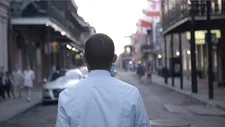 |
| CJ Hunt in contemplation |
AKT: You brought up so many things now, I don’t know where to start. Maybe the vulnerability. Mr. Hunt, CJ’s father enters the picture in a very interesting way, in the kitchen with an Aunt Jemima product on the counter. That is the comedy brain, and the recounting of the father’s visit to his school is more the storytelling brain?
JH: Yes, I think at that point CJ was just beginning to really kind of reckon with his own place within this story. There’s the comedy part of it because CJ’s dad is so incredibly charming and has become the kind of runaway star of this film. This was not just an historic explainer. This was really somebody trying to tell a really eloquent story about history and current events but also their place within it.
AKT: You made a good point about history in this country - and nobody is really exempt from that. In some respect we are all faking it with our knowledge of history. And a certain naiveté coming in makes it personal and at the same time universal.
One of the most terrifying moments is when the young guy in the khakis near the end at the rally in Charlottesville pleads why he was there “I just came for the fun.” I think we are at an important point in time of rethinking history, American history and world history.
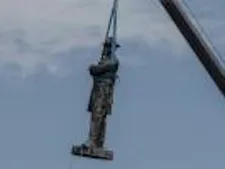 |
| Robert E Lee statue in New Orleans being removed |
JH: Having CJ on screen, having your director as a character is something that was so popular ten to 15 years ago. Someone like Michael Moore chasing a story around. On paper it doesn’t maybe sound terribly original, but in the case of this story, to be able to follow someone reckoning with this story alongside you, I think invites the audience to be vulnerable themselves and not knowing everything or admitting a blindspot they had.
CJ and I went over and over the text and made sure that it was truthful to CJ’s perspective, that it was always pointed in the right direction historically. There are moments where you have to take the perspective of the widows of the Confederacy. Without making it a sob story about them we also have to ask you to take their perspective for a second, but we don’t want to push it too far where we suddenly made them the victims. It was really a deep exercise of thinking about perspectives, about history, and then your own place within that, I think.
AKT: The history of the monument to the White League is really quite shocking. The fact that in the inscription white supremacy was added in 1937, which is two years before Gone With The Wind. The waves in popular culture in inventing history are so interesting.
JH: I think the phrase you just used, “inventing history” is so right on. It truly is a case in watching history being invented in real time. In a number of states CJ was no longer allowed to show this film in schools because of some of the laws that are currently being passed around what can be taught in schools in terms of race.
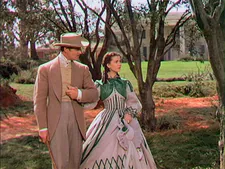 |
| Rhett (Clark Gable) to Scarlett (Vivian Leigh) “Maybe I’ve always had a weakness for lost causes” in Gone With The Wind |
And essentially this larger panic around critical race theory. We are watching that play out in real time. I don’t think we would have been able to see that had we not gone all the way back to the Civil War and started there.
AKT: It’s so terrifyingly timely! Regarding the “Lost Cause” you show a Currier & Ives image in the documentary and clips from Gone with The Wind. Rhett Butler has the line “Maybe I’ve always had a weakness for lost causes.” He says this to Scarlett, directly feeding the myth.
Shirley Temple [in David Butler’s The Littlest Rebel], Bette Davis [in William Wyler’s Jezebel], the manufacturing was ongoing. At the very end CJ asks this great question: “Which timeline are we on?” When exactly was your film finished?
JH: CJ and Darcy [McKinnon] started on the film in 2016 and then we finished the film in 2021. So there is a full arc of Confederate monuments being a local issue that monuments cannot be taken down without a massive fight, just to get four down in one city, all the way to what happened in 2020 where you saw them being pulled down overnight by crowds of people.
So there was a full arc of our relationship to these monuments shifting. We had to make sure that it reflected the time that we were finishing it and not the time that we started it. Because everyone’s understanding to history, to racist systems, to all these things had evolved so quickly in such a short amount of time in the public discourse that we had to make sure the questions we asked were reflective of the times we were in.
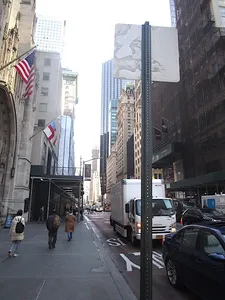 |
| Fifth Avenue and 53rd Street in Manhattan on the morning of April 4, 2023 Photo: Anne-Katrin Titze |
AKT: At times you may wonder, oh yes, this was before Charlottesville, and then you go there. A lot happened in these few years. Early on we hear about contractors getting threats and a car torched. We are in the middle of this. What may not have been thinkable ten years ago, is almost matter of fact now.
JH: I think that’s a great point. I think you’re exactly right. For as much as the United States loves history and we love to celebrate these through-lines that we believe are through our historical narrative of bravery and patriotism and equality and all these things, when you look at it there are these through-lines of inequality and racism and all those things we are talking about in the film.
There’s also a long long lineage of disinformation. Of propaganda, of inventing history to use the phrase you said earlier. Where the narratives that people devour about the place where they live and the nation that they call home are very purposefully built.
There’s nothing to be ashamed of, but there is something we need to understand - these are stories that are constructed for us. As more people are given language to express those things, I think we are able to move in a direction where progress is able to be made. As we talk in the film about what happened to the contractors, about Charlottesville - wherever there is progress, there is backlash. The more the progress moves and evolves, the backlash also moves and evolves. The better we become at speaking about some of these through-lines in our history, the backlash to that becomes better at dismissing it and gaslighting us.
AKT: There’s a lot of research behind your film.
JH: There is some heavy historical exposition that has to happen in order to get people on the same page with some of the stuff that we had learned. We’re going back through original documents. We were nominated for a duPont Award, which is often something that is given to journalists who do really original reporting. We were nominated for this purely because of depth of original research that CJ and some of the people working with him did.
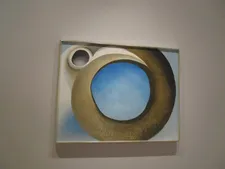 |
| Georgia O'Keeffe: To See Takes Time at MoMA in New York Photo: Anne-Katrin Titze |
It was such original historical research that when I came in and what I was working on was helping us tell the story in a way that was easy to follow and really interesting and personal to the people in the audience. That was me going through the script and rewriting things. People are watching a movie about CJ, they don’t want to get too lost in the history, but they also want the history, they want to learn those things.
AKT: The omniscient little bell ringing whenever someone tells a lie - that felt so good! You would want that in real life! Who came up with that?
JH: That’s a great question! There’s a scene where CJ, Darcy and Jeremy [Blum] went out into the field and went to the Confederate reenactment. There were so many lies, or for being kind, so much disinformation, so many points of propaganda were being said, that it was CJ’s idea to be like - what if we put a bell every time they say something that we’ve already highlighted earlier? But it was just within this one scene. Later I was working with CJ and I was like, hey, if I put myself in the place of the viewer, that was really gratifying.
I’ve worked in journalism and one of the most challenging things is when you are speaking with people who are not telling the truth. How do you handle disinformation? Usually you have to clarify. This bell is the way that you are reminding people of the fact that this is not true and it’s now a joke. Let’s put this all the way through the film. It’s a joke that we now are all in on, it’s also a teaching tool and very editorially responsible to say that’s not true. It’s a fun idea he had that I helped him pull all the way through.
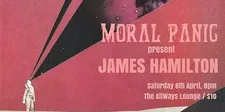 |
| Moral Panic present: James Hamilton stand-up comedy at the Allways Lounge in New Orleans |
AKT: It’s beautiful especially because you don’t explain it! We all get it and it’s perfect. Thank you!
JH: Thank you!
Moral Panic present: James Hamilton stand-up comedy at the Allways Lounge in New Orleans took place last night, Saturday April 8, 2023.
Georgia O'Keeffe: To See Takes Time at the Museum of Modern Art in New York opens today, Sunday April 9 through Saturday August 12.





















